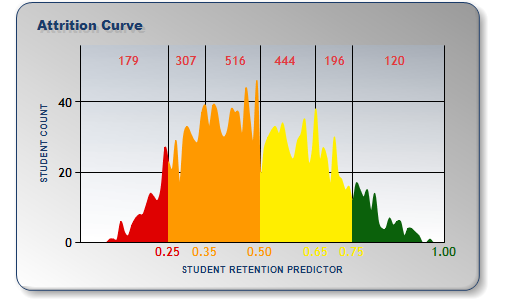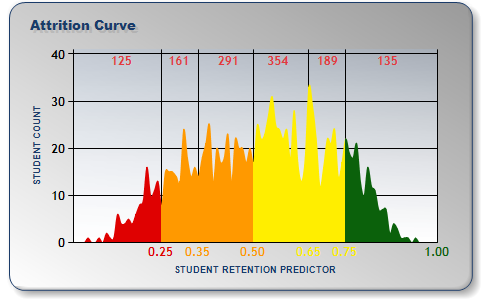student success
Ideas for Your Re-Enrollment Management Plan
In normal times for four-year colleges and universities, when students persist and progress to year three, student attrition usually drops to the low single digits. It’s why most of the re-enrollment management plans we help campuses develop are based on the first two years of the student lifecycle. For our community college friends, the re-enrollment pattern is different, but the process to make predictions and anticipate outcomes is similar.
You can see how this works in the charts below that show retention predictions for 2019 new students and 2018 students who returned to year two. These charts show an example from the RNL Student Retention Predictor, which assigns scores from 0.0-1.00 showing how likely a student is to stop out or persist.
In the first chart for 2019 first-year students, we can see that 516 students in the .35-.50 score band historically retain at about 58 percent.
First-year students – your 2019 class

The next example for the second-year students from the 2018 class shows 354 students in the score band of .50-.65 retaining on average at 72 percent.
Second-year students – your 2018 class

But as I said at the beginning, these models apply to “normal times.” How will they apply in these uncertain times? What do we do about student success when there’s no precedent to model
Some ideas on student success and re-enrollment management for the current times
We have heard from many of you and we are listening. We know that you are all slammed with the process of moving to virtual delivery of instruction, academic support, advisement, and other necessary functions to help students and their families.
We know you’re doing your best in this difficult time. The Student Success team at RNL wanted to offer some ideas as you think about your re-enrollment management (retention) and completion management plans.
For retention and completion purposes, you are working with two groups of students: currently enrolled students and students you may want to recruit back.
Currently enrolled students
1. Commencement and completion planning
How are you soothing disappointment regarding the typical May or June ceremony cancellation? Are virtual ceremonies in your plan? Can you offer a face-to-face ceremony later in the year even though you may issue diplomas prior to that? Have you asked your students and their families what they would like?
2. CAN: Congratulating, Alerting, and Nudging
Congratulating, alerting, and nudging are more important than ever in these uncertain times. Don’t forget to “congratulate” your students and their families as milestones are achieved in virtual instruction, advisement, and academic and co-curricular achievement.
3. Advising and registration campaigns
We have heard from many of you that you are using an all-hands-on-deck for advisement and registration efforts. April 1st is a common date to open registration for summer and fall. If you can, do it now. Make it easy for students to get registered.
4. Melt management for registration
Monitor registration melt starting now and throughout the summer. Remember, that advisement and registration campaigns are the primary strategies you use to manage enrollment.
Create an intent to reenroll tracking mechanism by asking these questions:
- I plan to complete my degree/certificate?
- I plan to transfer to another college or university?
- College is not right for me currently; I don’t plan to re-enroll.
- I have not decided about re-enrollment for next term.
5. Parent and family campaigns
If you have time, please reach out to parents and families. Ask them how you can help. Let them know that their students’ success is top of mind. Let them know how you are still providing value even in these uncertain times.
6. Maximize the connections to their academic homes
Students usually spend the most time with their faculty members. How have you considered maximizing these connections to their academic homes? How have you supported faculty members to make these connections?
7. Transcript request monitoring
Create a process to monitor transcript requests. Enable those who have relationships with students to reach out to students who request transcripts be sent to another college or university. Please be reasonable. Some students should be requesting transcripts be sent to another college—some should not.
8. Financial aid reminders
This goes without saying. We believe most of you are already doing this well.
9. Hold management communication
It is likely that you have placed registration holds on student accounts. Please review your policies keeping in mind that they may need to be loosened in these difficult times.
10. Housing/Residence life intent notices
Create a system where housing and residence life staff can report intent to live in housing (or not) for the upcoming year.
Students who you may want to recruit back (not currently enrolled)
- Ensure you are not communicating with students who have overwhelming barriers for return.
- Take the pulse of the drop-out student to gauge their interest.
- Target messages based on how your students respond.
- Develop the re-enrollment marketing plan to maximize your outcomes.
Let’s continue our exploration of re-enrollment strategies for this unprecedented time
This is complex issue, and we’re dive deeper into it during our webinar, Crafting Your Re-Enrollment Plan in Response to COVID-19. I invite you to join me as we discuss how to leverage the most effective strategies and develop a plan to predict retention outcomes in fall 2020.
Maybe you read an idea here that you hadn’t considered? Do you have a concern or challenge regarding student success during this crisis? We’re here to discuss your re-enrollment management plan. We’re all about collaboration, and this is an offer to bounce ideas off each other. It’s an offer to collaborate. It’s on offer to help you help your students. Isn’t that what we’re all about?
Simply make a request to talk with us and we’ll schedule a mutually convenient time with you.

